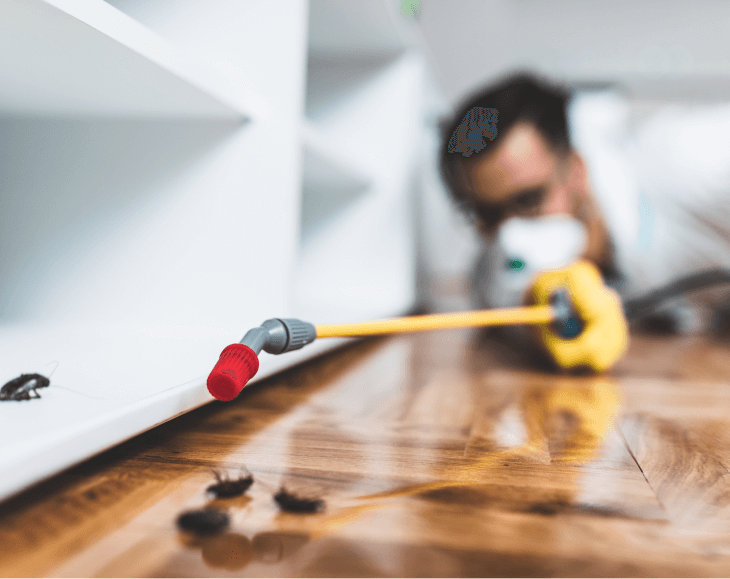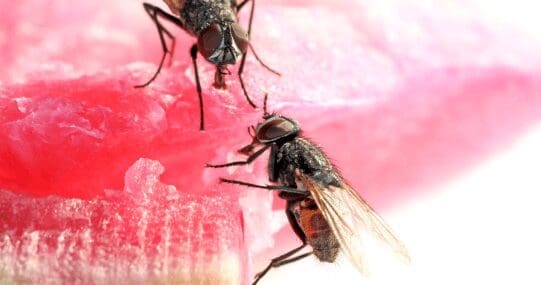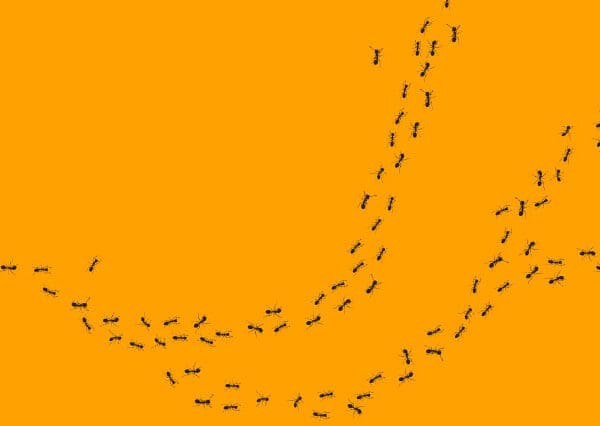
Residential Fly Control Services
Ensure that your home is, and stays, free of flies
Fly Pest Control
Rid your property of filth flies with our guaranteed 100% effective, professional fly control services.
“Filth flies” are so-known not just for the filth in which they feed, reproduce, and live – but also for the upsetting number of illnesses and diseases which they spread. Flies can enter the home with ease, through open windows or doors, inside vents or walls, and brought-in undetected on groceries or other food items. They may seem to be only a nuisance, but in addition to being a major source of agricultural damage, they’re one of the greatest vectors for the spread of disease in the world. Over 100 different pathogens are associated with the common housefly (from Salmonella to E. coli), and a single fly can have hundreds of millions of bacteria living on and inside of its body. Whenever a fly walks, grooms themselves, defecates, or eats, they are transferring massive amounts of dangerous pathogens to whatever surface they’re occupying.
At Bug Zapper, we understand the seriousness of getting rid of all those disgusting flies. In addition to our expertly-trained service professionals, our famous customer care, and our 100% satisfaction guarantee across all services, we also have the best-of-the-best in filth fly removal techniques developed by our in-house research team. If a fly infestation is causing you woes, or if you just want to make sure your space stays clean and pest-free, let Bug Zapper put your mind at ease and help you live fly-free!
Call
24/7
Customer Care and Pricing
Get Help From Our Experts
All Bugs Package
Ants, spiders, general pests, stingers, carpet beetles, interior and exterior fleas & ticks, and general pests.
- Service Starting At:
- $49
*Excludes: termites, mosquitoes & wood destroying insects.


Add Rodent Protection
Only $20/mo
 Bug Barrier Treatments
Bug Barrier Treatments Best Plan for Pets
Best Plan for Pets No Bugs. Period.
No Bugs. Period. Love it. Guarantee!
Love it. Guarantee! Unlimited Free Retreatments
Unlimited Free Retreatments
No Bugs. Period.
With our All Bugs Package, we guarantee you won’t have any creepy, crawly, biting, or stinging bugs on or in your home.
 No ants, no spiders, no fleas, no bedbugs, no cockroaches…NO bugs.
No ants, no spiders, no fleas, no bedbugs, no cockroaches…NO bugs.
How it works:
 We set up and maintain a Bug Barrier around your home.
We set up and maintain a Bug Barrier around your home. If a bug tries to cross that line, text us and we’ll take care of it faster than you can believe. It’s our No Bugs Guarantee.
If a bug tries to cross that line, text us and we’ll take care of it faster than you can believe. It’s our No Bugs Guarantee.
Basically, if you ever want to see bugs, you’ll have to go camping!
BUG ZAPPER’S PROMISE:
NO PESTS  Period
Period
With years of experience, continued education, and our expertise, we provide the best service and customer experience.

Fly Control FAQs
Choosing an ant control service for your home comes with many questions. When you’re ready to
learn more, call our office and talk with our friendly staff. We’ll ensure you get the answers you need
on our services, pricing, appointments and any other questions you may have.
What do you use to eliminate flies?
Bug Zapper is specially equipped for solving any fly-related pest issue. Our technicians first perform a detailed inspection to search for conditions conducive to infestation. Examples might include compost piles, pet feces, garbage systems, or decaying objects near the home. After addressing any conducive conditions or behaviors, our experts can significantly reduce filth flies within homes, commercial structures, and even in outdoor dining spaces. We use special residential bait products to provide a great solution for outdoor weddings and catered events. Additional options available within commercial structures produce amazing fly knockdown control. Bug Zapper is the leader in Oregon pest protection, even utilizing our own fly control devices created by our highly-trained research team. These innovations offer our customers the highest level of house fly protection and are just one of the many reasons we’re able to offer a 100% guarantee of satisfaction across all of our pest control services.
What are the most common types of fly in Oregon?
There are a wide variety of fly species in Oregon, and magnification is often required to determine the exact type of infesting fly. Among the most common flies we encounter are blowflies, house flies, lesser house flies, and fruit flies. If you need help identifying a species of fly, don’t hesitate to call our helpful and knowledgeable staff today.
What types of training do your technicians go through?
We are committed to providing you with knowledgeable, experienced technicians with a high level of technical expertise. Each of our technicians is fully licensed and certified in Oregon, in addition to undergoing advanced training though our internal apprenticeship training program. All technicians complete state testing for laws and safety, including IIHS General, IIHS Structural, and Agricultural Vertebrate tests before going through a month-long apprenticeship field training program. Our staff regularly completes ongoing advanced training and attends industry-based seminars. We are fortunate to have an Associate Certified Entomologist (ACE) on our staff – one of 12 in the whole state of Oregon currently.
Do you have same day service?
Same day service is available. We pride ourselves on fast response times and timely service appointments. We make every effort to prioritize your needs and to offer same day appointments when available. A technician can be at your home in most cases within 24-48 hrs. Call our office and we will gladly work with your schedule and time.
What are blowflies, and how are they controlled?
Blowflies (also known as carrion flies, bluebottles, greenbottles, or cluster flies) are shiny with a metallic coating and are often blue, green, or black. They infest dead flesh, and their presence is typically an indication of something dead nearby (such as a rotting squirrel or rabbit). Blowflies are capable of spreading disease and infection brought from the carrion on which they feed. However, control for blowflies is seldom needed, since within a few days mother nature reclaims the decaying flesh. Indoor swarms of blowflies are unusual and are typically the result of a dead animal decaying within the walls of a home.
What are house flies, and how are they controlled?
House flies are a leader in the filth fly category and spread disease wherever they go. They have grayish bodies, with dark stripes running the length of their thorax. The average housefly is capable of carrying more than a million bacteria on its body, and houseflies are known to spread diarrhea, typhoid, and cholera, among other things. Houseflies live, feed, and reproduce in the garbage, feces, and waste, and carry particles of filth from these environments into your home. The best way to prevent house flies from entering the home is through the use of screens for windows and doors.
What are lesser house flies, and how are they controlled?
Lesser house flies (also called little house flies) are, as the name would imply, quite small. These flies are only about five to six millimeters in length and have yellowish bodies. The tiny insects circle in large swarms – often for hours. They transfer dangerous particles and pathogens just like larger house flies and are also capable of landing in and standing on surfaces of liquid (such as in a glass of drinking water). They are usually found in cool, shaded locations, protected from the wind. Effective control methods include changing wind patterns by installing a fan and a knockdown treatment completed by our technicians.
What are fruit flies, and how are they controlled?
Fruit flies are the smallest of the listed fly varieties, and are often confused with gnats (though they are different species of fly, with fruit flies being more commonly found indoors). They are typically two to four millimeters in length, and are often tannish or brownish in color. Fruit flies are known by the FDA as a significant cause of food poisoning in the United States, due to the transmission of harmful bacteria onto food sources. Warm summer months provide an ideal setting for fruit flies to become especially troublesome within homes and restaurants. Fruit flies are attracted to fruits and vegetables (especially those that are overripe or spoiled). Most severe infestations occur when fruit is left out on counters or falls behind kitchen fixtures to rot undetected. Wherever possible, fruit should be stored inside refrigerators to decrease fruit fly activity. If fruit is removed and fruit flies remain, a detailed search of the kitchen should be conducted to discover where the flies are breeding within an undetected food source. Sanitation currently proves the most effective fruit fly control method.
Exceptional Value and Service
Looking for a better pest control experience? Our commitment to quality, satisfaction and service ensures you get the most value from your choice in pest services.

Highly Effective Solutions
Attention to detail, quality products, innovative solutions and in depth training to solve your pest problems.

Exceptional Customer Service
Friendly, accommodating and caring attention is given to every customer.

Lightning Fast Service
Prompt, Responsive and punctual service, your pest problem is our priority with same day service.

Free Re-Service
Attention to detail, quality products, innovative solutions and in depth training to solve your pest problems.

Upfront Pricing and Plans
Transparent, upfront pricing and plans. Three levels of service offered. No hidden costs, ever!
Related Articles
Get answers to your pest question now! Call or Text Us.

Convenient Locations
Looking for a trusted pest control company in your area? We serve cities throughout Oregon. Find complete and reliable pest control near you!

Plans & Pricing
We have a pest service plan for you! Our convenient plans give homeowners a range of affordable pest control pricing options.
AREAS WE SERVE


 Bug Barrier Treatments
Bug Barrier Treatments No ants, no spiders, no fleas, no bedbugs, no cockroaches…NO bugs.
No ants, no spiders, no fleas, no bedbugs, no cockroaches…NO bugs.
 Period
Period

